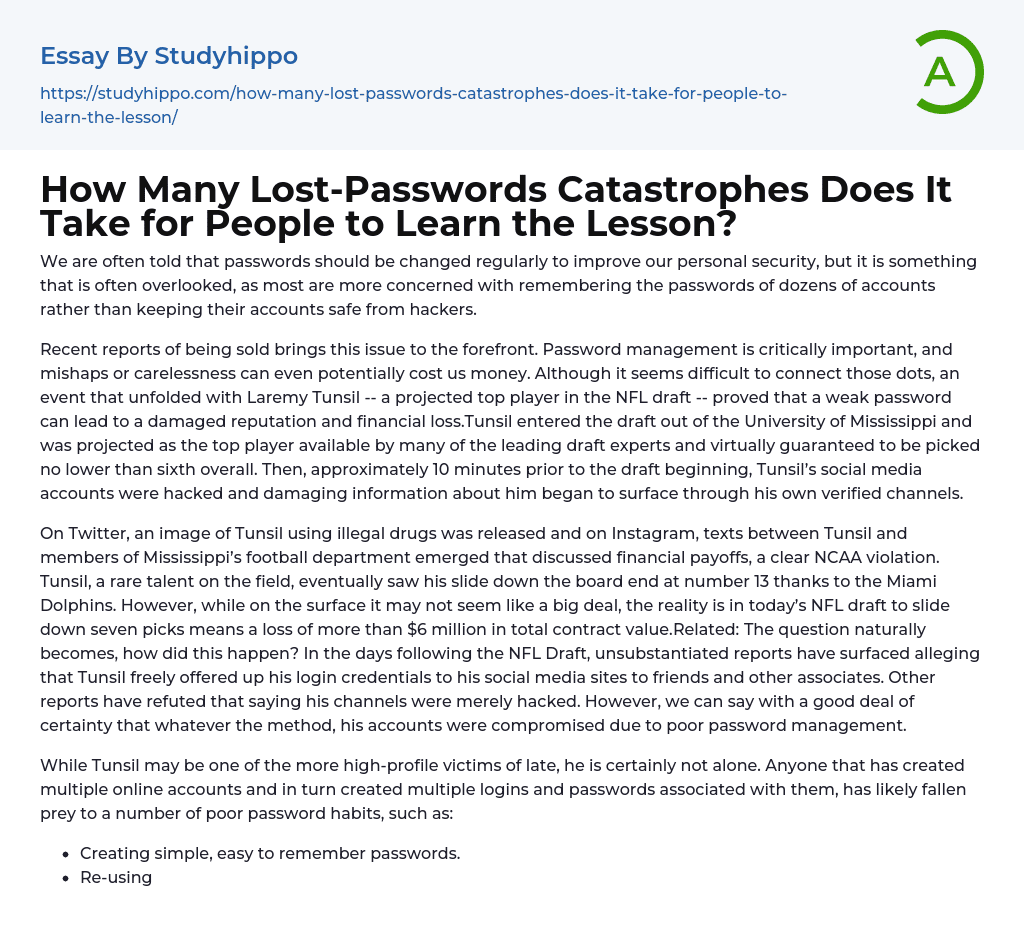

How Many Lost-Passwords Catastrophes Does It Take for People to Learn the Lesson? Essay Example
Despite the constant advice to update passwords for better personal security, individuals tend to prioritize memorizing numerous account passwords over safeguarding their accounts from possible hacking attempts.
Recent reports emphasize the significance of password management and the need to be vigilant in safeguarding your online presence, as mishandling or neglecting passwords can prove to be costly. This is exemplified by Laremy Tunsil's case, a top NFL draft prospect whose weak password led to damage to his reputation and potentially his financial future. Despite being considered the leading player available in the draft and expected to be selected no lower than sixth overall, just 10 minutes before the start of the event, Tunsil's verified social media accounts were hacked and damaging information was disseminated.
Twitter shared an image of Tunsil using illegal drugs, while Instagram uncovered text messages between Tun
...sil and members of Mississippi’s football department discussing financial payoffs. This was a violation of NCAA rules and resulted in Tunsil falling to number 13 in the NFL draft, losing over $6 million in total contract value, despite being a rare talent.
Related: According to reports, Tunsil either voluntarily gave his social media login details to friends or associates or his accounts were hacked. Regardless of the method used, poor password management led to the compromise of his accounts.
Tunsil is not the only one affected by poor password habits. People who create multiple online accounts and use multiple login credentials are also prone to this. These bad habits include creating simple and easy-to-remember passwords, reusing one password for different accounts, and storing passwords in an unsecured spreadsheet.
Although Laremy has less-than-perfect habits, he is not solely responsible for hi
compromised digital security. The growing trend of stringent password requirements on multiple websites has created a memory overload for humans and made online security nearly unattainable. While this challenge is understandable, it could have been prevented. To prevent becoming an easy target, individuals should take three actions to improve their social media account security - whether they are professional athletes or everyday people. Ensuring the utmost level of security for accounts should be a universal goal.
1. Creating Robust and Distinct Passwords for All Accounts
To safeguard against hackers, it is imperative to establish lengthy and distinct passwords for each account. This deters assaults on other accounts utilizing passwords obtained from data breaches or alternative sources. Even if the user's account is not the primary target of a hack, compromised password hashes can enable attackers to launch mass attacks on all users on the list.
To enhance security and prevent potential data breaches, it is crucial to store passwords appropriately. Inadequate storage of passwords could lead to attackers accessing all users' passwords. To improve security, it is recommended to create complex passwords that do not contain words from dictionaries or personal information like pet names or birthdays. A strong password example would be #IP9PqjS%17pEbUOkMVv.
Related:
2. Use a password manager for account organization.
If remembering a strong password seems challenging, consider using LastPass - a password manager that generates secure and lengthy passwords for online accounts (including social media). These managers securely store the passwords for easy accessibility.
It is simple to use unique passwords by automatically filling login pages with your credentials. Moreover, users can enhance their security by implementing an additional step of authentication. Two-factor (or multifactor) authentication
is a straightforward and efficient approach that is increasingly accessible through portable and user-friendly options.
Related:
3. Add another authentication step.
Two-factor authentication enhances login security by requiring users to provide an additional form of identification beyond their usual username and password. This extra layer of protection could be a code, a temporary password, or authenticating with a fingerprint before accessing their account. It's important to bear in mind that having two levels of security is always preferable to just one!
- Android essays
- Application Software essays
- Benchmark essays
- Computer Network essays
- Computer Programming essays
- Computer Security essays
- Computer Software essays
- Cryptography essays
- Data collection essays
- Data Mining essays
- Graphic Design essays
- Information Systems essays
- Internet essays
- Network Security essays
- Website essays
- World Wide Web essays
- Cloud Computing essays
- Computer Science essays
- Consumer Electronics essays
- Data Analysis essays
- Electronics essays
- engineering essays
- Enterprise Technology essays
- Hardware essays
- Impact of Technology essays
- Information Age essays
- Information Technology essays
- Modern Technology essays
- Operating Systems essays
- people search essays
- Robot essays
- Anthropology essays
- Audience essays
- Charity essays
- Cultural Competence essays
- Emile Durkheim essays
- Gender Roles essays
- Generation essays
- Globalization essays
- Interpersonal Relationship essays
- People essays
- Race essays
- Social Change essays
- Social Class essays
- Social Movement essays
- Social Science essays
- Social Status essays
- Social Stratification essays
- Society essays
- Sociological Imagination essays



